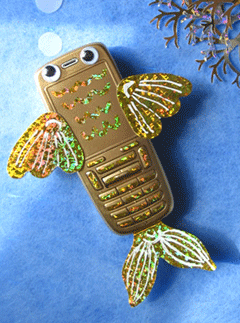Dial-A-Fish
Air Date: Week of November 9, 2007

Not this kind of fish phone! (Photo: Sue Allen)
When you’re in the supermarket or ordering fish at a restaurant, ever have trouble remembering which species has high mercury, which is overfished, and which is the most sustainable? Now, a new text messaging service will tell you everything you need to know about one fish, two fish, red fish or blue fish. Living on Earth’s Ashley Ahearn takes her cell phone to a local market to find out how the Fish Phone works.
Transcript
GELLERMAN: When you’re in a restaurant or a grocery store, thinking about fish for supper, you might also want to think about what could be in the fish—maybe mercury, perhaps PCBs? Or maybe the fishery is floundering. Some fish are good—some not—but can you remember which fish is which? Now you don’t have to—you can let your fingers do the fishing, as Living on Earth’s Ashley Ahearn learned when she dialed-a-fish at her local supermarket.
[SOUNDS OF GROCERY STORE, BEEPING, PEOPLE WALKING]
AHEARN: So I’m going to type in ‘swordfish’ and see what comes up.
[CELL PHONE TEXT MESSAGE SOUND]
AHEARN: It says; Atlantic and Mediterranean caught, few environmental concerns. It got a green rating. And they’re high mercury, though. Okay, so maybe I won’t do swordfish. I’m trying salmon now.
[CELL PHONE TEXT MESSAGE SOUND]
AHEARN: But for wild salmon it says it’s fine. So I guess farmed salmon is off the menu for dinner, too.

Not this kind of fish phone! (Photo: Sue Allen)
SAFINA: You simply send a text message with the word ‘fish’ and the name of the fish that you are interested in and virtually instantly, you will get a beep on your phone and you will see whether you should tell the waiter that that’s what you want to eat or you should tell the guy behind the counter or the woman behind the counter that that’s what you want to buy.
AHEARN: So it’s kind of like cheating in a way.
SAFINA: Uh, it’s kind of like being a very informed consumer and feeling kind of smug about it.
AHEARN: Carl Safina and his team have put together a database that rates each fish based on pollution exposure, fishing practices, population levels, even how long it takes that species to reproduce.
SAFINA: And then we score all those things and then we relate the score to a color code and the code sort of ranges from green to light green to yellow to reddish yellow to red.
AHEARN: I think Dr. Seuss wrote a poem about that.
SAFINA: Yes, he did (laughs). Maybe subliminally that was our inspiration all along.
AHEARN: But beyond the rating system, Carl has some basic rules of thumb for anyone buying fish, even if they don’t have text messaging on their phone.
SAFINA: Farmed shellfish is generally very good and then the smaller the fish is, the better it’s likely to be. The bigger the fish, the more fished out it probably is and the more you might have a concern about mercury or other pollutants. But there are some surprises. For instance, the swordfish have come back up and they’re doing much better than they were a decade ago.
[SOUND OF GROCERY STORE, BEEPING AND PEOPLE TALKING]
AHEARN: That doesn’t really help me for dinner, though. Swordfish is a little bit out of my price range. But Safina says farmed shellfish is good. So, I’ll text the number 30644, the word ‘shrimp,’ and let’s see what my phone spits out now.
[CELL PHONE TEXT MESSAGE SOUND]
AHEARN: Oh, okay, so if I get farmed shrimp, I’m okay, it looks like, from here. So shrimp it is for dinner. Thank you Carl Safina. Thank you Fish Phone. Alright, great. Can I get a half a pound of the farm-raised—
For Living on Earth, I’m Ashley Ahearn.
[MUSIC: Taj Mahal “Fishing Blues” from ‘The Real Thing’ (Sony Music—1972)]
Links
Living on Earth wants to hear from you!
Living on Earth
62 Calef Highway, Suite 212
Lee, NH 03861
Telephone: 617-287-4121
E-mail: comments@loe.org
Newsletter [Click here]
Donate to Living on Earth!
Living on Earth is an independent media program and relies entirely on contributions from listeners and institutions supporting public service. Please donate now to preserve an independent environmental voice.
NewsletterLiving on Earth offers a weekly delivery of the show's rundown to your mailbox. Sign up for our newsletter today!
 Sailors For The Sea: Be the change you want to sea.
Sailors For The Sea: Be the change you want to sea.
 The Grantham Foundation for the Protection of the Environment: Committed to protecting and improving the health of the global environment.
The Grantham Foundation for the Protection of the Environment: Committed to protecting and improving the health of the global environment.
 Contribute to Living on Earth and receive, as our gift to you, an archival print of one of Mark Seth Lender's extraordinary wildlife photographs. Follow the link to see Mark's current collection of photographs.
Contribute to Living on Earth and receive, as our gift to you, an archival print of one of Mark Seth Lender's extraordinary wildlife photographs. Follow the link to see Mark's current collection of photographs.
 Buy a signed copy of Mark Seth Lender's book Smeagull the Seagull & support Living on Earth
Buy a signed copy of Mark Seth Lender's book Smeagull the Seagull & support Living on Earth

